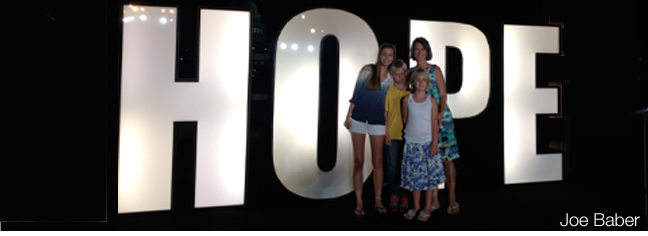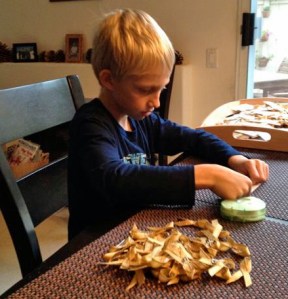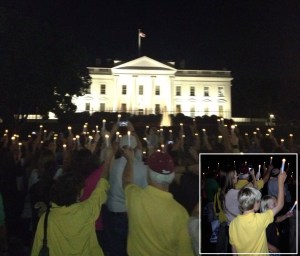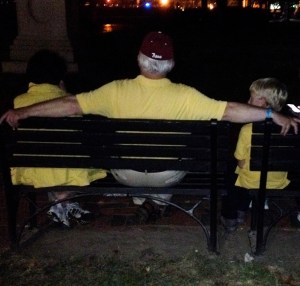 From his perspective, my then 10 year-old grandson Conor has always had a somewhat normal
From his perspective, my then 10 year-old grandson Conor has always had a somewhat normal  childhood. He lives in California, is good in school, a cool blond-headed surfer dude and a wild and radical skateboarder. In fact, I am amazed when I watch him on his board as he navigates a particular skateboard park in Coronado popping in and out of the deep pools “getting air” and landing safely on the rim. This has been the life his parents wanted for him and even prayed for him to have when he was diagnosed with high-risk neuroblastoma at 15 months old..
childhood. He lives in California, is good in school, a cool blond-headed surfer dude and a wild and radical skateboarder. In fact, I am amazed when I watch him on his board as he navigates a particular skateboard park in Coronado popping in and out of the deep pools “getting air” and landing safely on the rim. This has been the life his parents wanted for him and even prayed for him to have when he was diagnosed with high-risk neuroblastoma at 15 months old..
Conor’s ordinary life started to unravel when he was about nine years old. Then his natural curiosity got the best of him. He picked up a Nicholas Conor Institute leaflet on his mom’s desk and asked, “Hey mom, why are they using my name?” Conor didn’t remember, and my daughter Beth Anne and her husband Nick never really let him know that they almost lost him to cancer. They wanted him to have a normal life and did everything they could to make that happen, but now Conor was getting curious and really noticing what his mom was working on.
When Conor asked, Beth Anne told him in a very gentle manner and as time passed, she gave him more and more details about those early years. He never liked the idea of being a cancer survivor and avoided any and all conversations outside of the family. He did not want to be considered “special.” He felt awkward. He really did not care for the reactions he got from strangers when they found out he was a survivor.
gave him more and more details about those early years. He never liked the idea of being a cancer survivor and avoided any and all conversations outside of the family. He did not want to be considered “special.” He felt awkward. He really did not care for the reactions he got from strangers when they found out he was a survivor.
One day in school, during a health lesson with a large group of kids, the instructor asked if any one there had cancer or knew someone that did. Conor could not raise his hand. He did not want to be different from the others. Across the room, a boy in his class stood up and said he had neuroblastoma when he was four and talked about it. BINGO! Conor connected with his new best friend who, like him, was a cancer survivor. Afterwards they compared port and surgery scars and so forth. They are very close friends today and the relationship helped Conor be able to talk about cancer.
Nine years ago, Beth Anne decided to bring Conor (then 10 yrs-old) to Childhood Cancer Awareness Week and CureFest always held in September and involve him in all the activities. It was time to immerse him into the world of childhood cancer. She brought Conor and his sisters, Grace and Cami to Washington, DC where my wife Ellie and I joined up with them. We made a week of participating in cancer  related events from the American Cancer Society’s Lights of Hope on Tuesday, advocating for more research while visiting Congress on Wednesday, to Golden Toast on Thursday and CureFest on Friday through Sunday.
related events from the American Cancer Society’s Lights of Hope on Tuesday, advocating for more research while visiting Congress on Wednesday, to Golden Toast on Thursday and CureFest on Friday through Sunday.
All during the week Conor watched, listened and talked about cancer. At first there was a lot of hesitation and apprehension. By Thursday, he was doing better. At a Golden Toast reception attended by 150 people for Congressmen McCaul and Van Hollen, co-chairs of the Congressional Caucus on Childhood Cancer, Conor gave a little talk on the gold flashlights that were being given to the guests as a symbol of shining a light on cancer. That was a first for him and he did it well.
 It all came together on Saturday night for Conor at the very first Golden Lights candlelight vigil in Lafayette Park, just across the street from the White House. It was held to honor the children who died because of cancer. First, our little man and other survivors were recognized. Afterwards, I watched Conor listen intently to each parent who spoke about the child they lost. There was complete silence in the huge crowd of about 1,000 as one by one gave very compassionate testimony what their child and their family went through in their own battle against cancer only to lose their child in the end. It was chilling. From there, we all moved silently to the gates of the White House where all of us in unison raised golden flame candles and sang Amazing Grace. It was the most moving and chilling event I have ever seen.
It all came together on Saturday night for Conor at the very first Golden Lights candlelight vigil in Lafayette Park, just across the street from the White House. It was held to honor the children who died because of cancer. First, our little man and other survivors were recognized. Afterwards, I watched Conor listen intently to each parent who spoke about the child they lost. There was complete silence in the huge crowd of about 1,000 as one by one gave very compassionate testimony what their child and their family went through in their own battle against cancer only to lose their child in the end. It was chilling. From there, we all moved silently to the gates of the White House where all of us in unison raised golden flame candles and sang Amazing Grace. It was the most moving and chilling event I have ever seen.
When the vigil ended, we sat on a park bench in front of the White House facing the park  where all the parents had talked about their experiences. Conor looked up at me with his eyes full of innocence and said, “Grandpa Joe, what do you think about all of this?” Trying to not let my voice waiver, I said, “No one…no one person who was here tonight will ever forget this particular night for the rest of their lives.” I told Conor he was providing Hope for others whose children are diagnosed with cancer. He is a sign of Hope for others and in order for them to have courage to fight, they need Hope and he could provide that sign by just being himself. While rubbing the top of his head, I asked him, “What do you think about all of this?” He looked up and replied, “ I am so very, very lucky.” We hugged, I held him close so he could not see the tears in my eyes and at that moment all I could say was simply, “You’re right.”
where all the parents had talked about their experiences. Conor looked up at me with his eyes full of innocence and said, “Grandpa Joe, what do you think about all of this?” Trying to not let my voice waiver, I said, “No one…no one person who was here tonight will ever forget this particular night for the rest of their lives.” I told Conor he was providing Hope for others whose children are diagnosed with cancer. He is a sign of Hope for others and in order for them to have courage to fight, they need Hope and he could provide that sign by just being himself. While rubbing the top of his head, I asked him, “What do you think about all of this?” He looked up and replied, “ I am so very, very lucky.” We hugged, I held him close so he could not see the tears in my eyes and at that moment all I could say was simply, “You’re right.”
On the way back to our hotel we talked more and the next day at CureFest we talked again. We will talk a lot in the coming days, weeks and years. Not only is Conor lucky, but so are we…
Author: Joe Baber, Conor’s Grandfather
Updated: Conor (Boddy) who was diagnosed with Neuroblastoma at 15 months of age is now 20 years old and has a passion for Downhill Mountain Bike Racing. He is on a pro team, BikesOnline Racing. If you are looking for Hope, Check This Out!
Related Articles: Survivor, Survivor 2nd Edition and Help Save Hope














Grandpa Joe, thanks for sharing. Conor is brave young man and is lucky to be surrounded by loving and caring family.
wow! well written Joe!
🙂 Be Happy
Simply beautiful. Thank you for sharing Conor with us. Every child diagnosed should be “lucky” as Conor said. There is a lot more than just hope in that story. Thanks papa bear.
Absolutely moving. I understand the agony your family has been through–and we are the lucky families. I am the grandmother of the blue-eyed pig-tailed child pictured to the right.
Thank you for sharing Donna, it’s good to “meet” a fellow grandparent involved in our community.
I have chills. What a beautiful story. We are there on Sunday and it was just awesome.